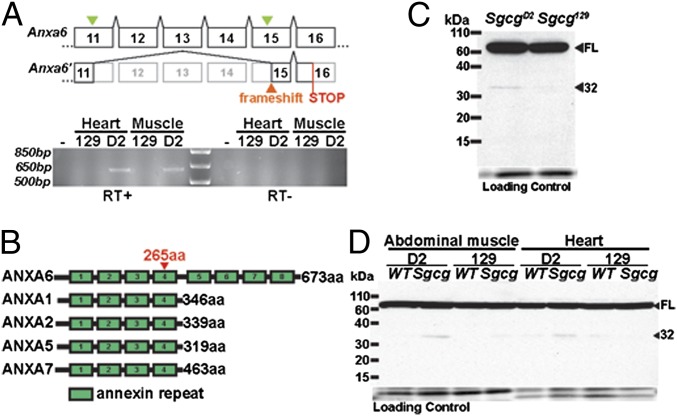Fig. 2.
A splice variant of Anax6 is differentially expressed between the severe D2 strain and the mild 129 strain in heart and muscle. (A) Anxa6 contains a number of variants between the D2 and 129 genomes. Two synonymous variants occur in exons 11 and 15 (green arrows). Sanger sequencing of the additional RT-PCR product (Anxa6’) identified a splice junction between the middle of exon 11 and the middle of exon 15. The exon 11–15 junction deletes 124 amino acids and disrupts the reading frame of the transcript resulting in a premature STOP codon in exon 16. RT-PCR specific for the alternate splice form shows the alterative splice form in muscle and heart cDNA only in the D2 background. (B) The annexins are calcium-dependent membrane binding proteins. Annexin A6 is highly expressed in heart and muscle and uniquely contains eight annexin repeats (21). The alternate splice form of ANXA6 observed in D2 mice is predicted to truncate annexin A6 at amino acid 265 (red arrowhead) removing four carboxyl-terminal annexin repeats. (C) Immunoblotting with an anti-annexin A6 antibody recognizing an amino-terminal epitope detects high level expression of full-length annexin A6 in Sgcg hearts [68 kDa, full length (FL)]. An additional protein, ∼32 kDa (32), referred to as ANXA6N32, was present at higher levels in Sgcg hearts from the severe D2 background compared with those from the mild 129 background. (D) ANXA6N32 was expressed in abdominal muscle at higher levels in Sgcg from the D2 background. On longer exposure, ANXA6N32 could be detected in Sgcg129 tissues at lower levels. Sgcg tissues expressed higher levels of ANXA6N32 than WT; 129 WT tissue expressed no or very little ANXA6N32.

